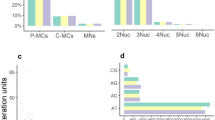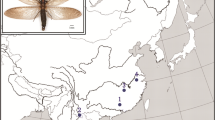Abstract
The cicada species Cryptotympana atrata and Hyalessa fuscata are abundant in metropolitan Seoul where their population densities are positively correlated with local urban heat island intensities. Here, we characterized two panels of polymorphic markers for both species. A set of 21 microsatellite markers previously developed for a Chinese population of C. atrata were tested for the Korean population. Fifteen of the tested loci were found to be polymorphic in the target population. The number of alleles per locus ranged from 2 to 12, with observed and expected heterozygosities ranging from 0.2 to 1 and 0.06667 to 0.92644, respectively. Four of the tested loci were moderately polymorphic, and the rest were highly polymorphic. For H. fuscata, a novel panel of microsatellite markers was generated using a next-generation sequencing technique and 18 polymorphic loci were identified in the target population. The number of alleles per locus was between 3 and 16, with observed and expected heterozygosities ranging from 0.02222 to 0.97778 and 0.16804 to 0.86181, respectively. Polymorphism level was low in one locus, moderate in five loci, and high in the remaining loci. The microsatellite markers described in this study will be useful for identifying genetic structure and genetic differentiation among populations of C. atrata and H. fuscata in metropolitan Seoul.
Similar content being viewed by others
Change history
24 May 2019
Unfortunately the title of the original publication contains a typo. Instead of (Hemiptera: Cicadoidae) it should be (Hemiptera: Cicadidae).
References
Selkoe KA, Toonen RJ (2006) Microsatellites for ecologists: a practical guide to using and evaluating microsatellite markers. Ecology letters 9(5):615–629
Vieira MLC, Santini L, Diniz AL, Munhoz CdF (2016) Microsatellite markers: what they mean and why they are so useful. Genetics molecular biology 39(3):312–328
Zhu W, Li H, Zhang H, Zhang H, Lv T, Xue S, Chen J (2016) Isolation and characterization of twenty-one novel microsatellite loci for the black cicada, Cryptotympana atrata. Applied entomology zoology 51(3):511–514
Heras S, Planella L, Caldarazzo I, Vera M, García-Marín J-L, Roldán MI (2016) Development and characterization of novel microsatellite markers by Next Generation Sequencing for the blue and red shrimp Aristeus antennatus. PeerJ 4:e2200
Souza DCL, Rossini BC, de Souza FB, Sebbenn AM, Marino CL, de Moraes MLT (2018) Development of microsatellite markers for Myracrodruon urundeuva (FF & MF Allemão), a highly endangered species from tropical forest based on next-generation sequencing. Molecular biology reports 45(1):71–75
Waikham P, Thongkumkoon P, Chomdej S, Liu A, Wangpakapattanawong P (2018) Development of 13 microsatellite markers for Castanopsis tribuloides (Fagaceae) using next-generation sequencing. Molecular biology reports 45(1):27–30
Kim TE, Oh S-Y, Chang E, Jang Y (2014) Host availability hypothesis: complex interactions with abiotic factors and predators may best explain population densities of cicada species. Animal Cells Systems 18(2):143–153
Nguyen HQ, Andersen DK, Kim Y, Jang Y (2018) Urban heat island effect on cicada densities in metropolitan Seoul. PeerJ 6:e4238
Van Oosterhout C, Hutchinson WF, Wills DP, Shipley P (2004) MICRO-CHECKER: software for identifying and correcting genotyping errors in microsatellite data. Molecular Ecology Resources 4(3):535–538
Peakall R, Smouse PE (2006) GENALEX 6: genetic analysis in Excel. Population genetic software for teaching and research. Molecular Ecology Resources 6(1):288–295
Peakall R, Smouse E (2012) GenAlEx 6.5: genetic analysis in Excel. Population genetic software for teaching and research—an update. Bioinformatics 28:2537–2539
Kalinowski ST, Taper ML, Marshall TC (2007) Revising how the computer program CERVUS accommodates genotyping error increases success in paternity assignment. Molecular ecology 16(5):1099–1106
Excoffier L, Laval G, Schneider S (2005) Arlequin (version 3.0): an integrated software package for population genetics data analysis. Evolutionary bioinformatics 1:117693430500100003
Rice WR (1989) Analyzing tables of statistical tests. Evolution 43(1):223–225
Hamilton M (2011) Population genetics. John Wiley & Sons
Buchman A, Deaton R, Randle C, Brummel T, Wilson E, Lutterschmidt W (2009) Isolation and characterization of polymorphic microsatellite loci for the three-toed box turtle (Terrapene carolina triunguis) and cross-amplification in other Terrapene species. Molecular ecology resources 9(4):1169–1171
Isoda K, Watanabe A (2006) Isolation and characterization of microsatellite loci from Larix kaempferi. Molecular Ecology Resources 6(3):664–666
Sun J, Li J, Yang X, Hong X (2012) Development and characterization of nine polymorphic microsatellites for the small brown planthopper Laodelphax striatellus (Hemiptera: Delphacidae). Genet Mol Res 11(2):1526–1531
Funding
Funding was provided by National Research Foundation of Korea (Grant No. 2015R1A4A1041997).
Author information
Authors and Affiliations
Corresponding author
Ethics declarations
Conflict of interest
The authors declare that they have no conflict of interest.
Additional information
Publisher’s Note
Springer Nature remains neutral with regard to jurisdictional claims in published maps and institutional affiliations.
Electronic supplementary material
Below is the link to the electronic supplementary material.
Rights and permissions
About this article
Cite this article
Nguyen, H.Q., Chae, S., Kim, E. et al. Characterization of polymorphic loci for two cicada species: Cryptotympana atrata and Hyalessa fuscata (Hemiptera: Cicadoidae). Mol Biol Rep 46, 1555–1561 (2019). https://doi.org/10.1007/s11033-018-4571-3
Received:
Accepted:
Published:
Issue Date:
DOI: https://doi.org/10.1007/s11033-018-4571-3




